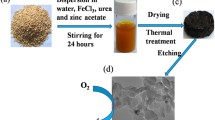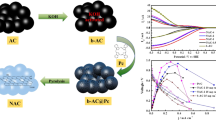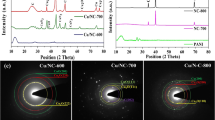Abstract
Nitrogen-doped porous carbon nanowires with polypyrrole as precursor are synthesized by modified oxidation template assembly method. The nitrogen-doped porous carbon nanowires air cathode microbial fuel cells present a maximum power density of 1641.7 ± 0.7 mW m−2, a significant exchange current density of 19.97 × 10−4 A cm−2 and an outstanding open circuit voltage of 0.303 V, which are all higher than the control. Nitrogen-doped porous carbon nanowires modified activated carbon catalyzes oxygen reduction reaction via a four-electron reaction with an electron transfer number of 3.89, which can be comparable with Pt-based catalyst. It is testified that the nitrogen-doped porous carbon nanowires are featured with the structure and morphology of surface porous amorphous nanocarbon structure doped with large content of nitrogen. The incorporation of nitrogen, intertwined hollow nanowires, and the porous three-dimensional network configuration make an outstanding contribution to the oxygen reduction reaction. Nitrogen-doped porous carbon nanowires are expected to be a new catalyst to improve the performance of the microbial fuel cells.










Similar content being viewed by others
References
Han H-X, Shi C, Yuan L, Sheng G-P (2017) Enhancement of methyl orange degradation and power generation in a photoelectrocatalytic microbial fuel cell. Appl Energy 204:382–389
Chen S, Patil SA, Schröder U (2018) A high-performance rotating graphite fiber brush air-cathode for microbial fuel cells. Appl Energy 211:1089–1094
Xia W, Mahmood A, Liang Z, Zou R, Guo S (2016) Earth-abundant nanomaterials for oxygen reduction. Angew Chem Int Ed Eng 55:2650–2676
Qi J, Xin L, Zhang Z, Sun K, He H, Wang F, Chadderdon D, Qiu Y, Liang C, Li W (2013) Surface dealloyed PtCo nanoparticles supported on carbon nanotube: facile synthesis and promising application for anion exchange membrane direct crude glycerol fuel cell. Green Chem 15:1133
Yu X, Ye S (2007) Recent advances in activity and durability enhancement of Pt/C catalytic cathode in PEMFC. J Power Sources 172:145–154
Trapero JR, Horcajada L, Linares JJ, Lobato J (2017) Is microbial fuel cell technology ready? An economic answer towards industrial commercialization. Appl Energy 185:698–707
Snyder J, Fujita T, Chen MW, Erlebacher J (2010) Oxygen reduction in nanoporous metal-ionic liquid composite electrocatalysts. Nat Mater 9:904–907
Alatraktchi FA, Zhang Y, Angelidaki I (2014) Nanomodification of the electrodes in microbial fuel cell: impact of nanoparticle density on electricity production and microbial community. Appl Energy 116:216–222
Seo J, Cha D, Takanabe K, Kubota J, Domen K (2014) Particle size dependence on oxygen reduction reaction activity of electrodeposited TaO(x) catalysts in acidic media. Phys Chem Chem Phys 16:895–898
Nekooi P, Amini MK (2010) Effect of support type and synthesis conditions on the oxygen reduction activity of RuxSey catalyst prepared by the microwave polyol method. Electrochim Acta 55:3286–3294
Liu M, Dong Y, Wu Y, Feng H, Li J (2013) Titanium nitride nanocrystals on nitrogen-doped graphene as an efficient electrocatalyst for oxygen reduction reaction. Chemistry 19:14781–14786
Sun T, Wu Q, Che R, Bu Y, Jiang Y, Li Y, Yang L, Wang X, Hu Z (2015) Alloyed Co–Mo nitride as high-performance electrocatalyst for oxygen reduction in acidic medium. ACS Catal 5:1857–1862
Wei W, Liang H, Parvez K, Zhuang X, Feng X, Müllen K (2014) Nitrogen-doped carbon nanosheets with size-defined mesopores as highly efficient metal-free catalyst for the oxygen reduction reaction. Angew Chem Int Ed 53:1570–1574
Park M, Lee T, Kim BS (2013) Covalent functionalization based heteroatom doped graphene nanosheet as a metal-free electrocatalyst for oxygen reduction reaction. Nanoscale 5:12255–12260
Tao H, Yan C, Robertson AW, Gao Y, Ding J, Zhang Y, Ma T, Sun Z (2017) N-Doping of graphene oxide at low temperature for the oxygen reduction reaction. Chem Commun (Camb) 53:873–876
Raj CR, Samanta A, Noh SH, Mondal S, Okajima T, Ohsaka T (2016) Emerging new generation electrocatalysts for the oxygen reduction reaction. J Mater Chem A 4:11156–11178
Zhao L, Baccile N, Gross S, Zhang Y, Wei W, Sun Y, Antonietti M, Titirici M-M (2010) Sustainable nitrogen-doped carbonaceous materials from biomass derivatives. Carbon 48:3778–3787
Tao H, Gao Y, Talreja N, Guo F, Texter J, Yan C, Sun Z (2017) Two-dimensional nanosheets for electrocatalysis in energy generation and conversion. J Mater Chem A 5:7257–7284
Maldonado S, Morin S, Stevenson KJ (2006) Structure, composition, and chemical reactivity of carbon nanotubes by selective nitrogen doping. Carbon 44:1429–1437
Graglia M, Pampel J, Hantke T, Fellinger TP, Esposito D (2016) Nitro lignin-derived nitrogen-doped carbon as an efficient and sustainable electrocatalyst for oxygen reduction. ACS Nano 10:4364–4371
Liu Q, Pu Z, Tang C, Asiri AM, Qusti AH, Al-Youbi AO, Sun X (2013) N-doped carbon nanotubes from functional tubular polypyrrole: a highly efficient electrocatalyst for oxygen reduction reaction. Electrochem Commun 36:57–61
Jia X, Wang C, Zhao C, Ge Y, Wallace GG (2016) Toward biodegradable Mg-Air bioelectric batteries composed of silk fibroin-polypyrrole film. Adv Funct Mater 26:1454–1462
Buitrago-Sierra R, García-Fernández MJ, Pastor-Blas MM, Sepúlveda-Escribano A (2013) Environmentally friendly reduction of a platinum catalyst precursor supported on polypyrrole. Green Chem 15:1981
Zhang X, Zhang J, Liu Z, Robinson C (2004) Inorganic/organic mesostructure directed synthesis of wire/ribbon-like polypyrrole nanostructures. Chem Commun (Camb):1852–1853
Yuan X, Ding X-L, Wang C-Y, Ma Z-F (2013) Use of polypyrrole in catalysts for low temperature fuel cells. Energy Environ Sci 6:1105
Su Y, Jiang H, Zhu Y, Yang X, Shen J, Zou W, Chen J, Li C (2014) Enriched graphitic N-doped carbon-supported Fe3O4 nanoparticles as efficient electrocatalysts for oxygen reduction reaction. J Mater Chem A 2:7281–7287
Liu H, Shi Z, Zhang J, Zhang L, Zhang J (2009) Ultrasonic spray pyrolyzed iron-polypyrrole mesoporous spheres for fuel celloxygen reduction electrocatalysts. J Mater Chem 19:468–470
Ćirić-Marjanović G, Mentus S, Pašti I, Gavrilov N, Krstić J, Travas-Sejdic J, Strover LT, Kopecká J, Moravková Z, Trchová M, Stejskal J (2014) Synthesis, characterization, and electrochemistry of nanotubular polypyrrole and polypyrrole-derived carbon nanotubes. J Phys Chem C 118:14770–14784
Gu L, Jiang L, Jin J, Liu J, Sun G (2015) Yolk–shell structured iron carbide/N-doped carbon composite as highly efficient and stable oxygen reduction reaction electrocatalyst. Carbon 82:572–578
Jiang H, Ma J, Li C (2012) Hierarchical porous NiCo2O4 nanowires for high-rate supercapacitors. Chem Commun (Camb) 48:4465–4467
Dong H, Yu H, Wang X, Zhou Q, Feng J (2012) A novel structure of scalable air-cathode without Nafion and Pt by rolling activated carbon and PTFE as catalyst layer in microbial fuel cells. Water Res 46:5777–5787
Liu Z, Ge B, Li K, Zhang X, Huang K (2016) The excellent performance and mechanism of activated carbon air cathode doped with different type of cobalt for microbial fuel cells. Fuel 176:173–180
Li X, Wang X, Zhang Y, Ding N, Zhou Q (2014) Opening size optimization of metal matrix in rolling-pressed activated carbon air–cathode for microbial fuel cells. Appl Energy 123:13–18
Sivasankaran A, Sangeetha D (2015) Influence of sulfonated SiO2 in sulfonated polyether ether ketone nanocomposite membrane in microbial fuel cell. Fuel 159:689–696
Sui ZY, Li X, Sun ZY, Tao HC, Zhang PY, Zhao L, Han BH (2018) Nitrogen-doped and nanostructured carbons with high surface area for enhanced oxygen reduction reaction. Carbon 126:111–118
Yang Q-S, Sui Z-Y, Liu Y-W, Han B-H (2016) Porous nitrogen-doped carbon nanoribbons for high-performance gas adsorbents and lithium ion batteries. Ind Eng Chem Res 55:6384–6390
Sui Z-Y, Wang C, Yang Q-S, Shu K, Liu Y-W, Han B-H, Wallace GG (2015) A highly nitrogen-doped porous graphene – an anode material for lithium ion batteries. J Mater Chem A 3:18229–18237
Zheng R, Mo Z, Liao S, Song H, Fu Z, Huang P (2014) Heteroatom-doped carbon nanorods with improved electrocatalytic activity toward oxygen reduction in an acidic medium. Carbon 69:132–141
Sui Z-Y, Wang C, Shu K, Yang Q-S, Ge Y, Wallace GG, Han B-H (2015) Manganese dioxide-anchored three-dimensional nitrogen-doped graphene hybrid aerogels as excellent anode materials for lithium ion batteries. J Mater Chem A 3:10403–10412
Sui ZY, Cui Y, Zhu JH, Han BH (2013) Preparation of three-dimensional graphene oxide-polyethylenimine porous materials as dye and gas adsorbents. ACS Appl Mater Interfaces 5:9172–9179
Chen L-F, Huang Z-H, Liang H-W, Yao W-T, Yu Z-Y, Yu S-H (2013) Flexible all-solid-state high-power supercapacitor fabricated with nitrogen-doped carbon nanofiber electrode material derived from bacterial cellulose. Energy Environ Sci 6:3331
Sui Z-Y, Meng Q-H, Li J-T, Zhu J-H, Cui Y, Han B-H (2014) High surface area porous carbons produced by steam activation of graphene aerogels. J Mater Chem A 2:9891
Park J-Y, Kwak D-H, Ma K-B, Han S-B, Chai GS, Kim S-K, Peck D-H, Kim C-S, Kucernak A, Park K-W (2018) Enhanced oxygen reduction reaction of Pt deposited Fe/N-doped bimodal porous carbon nanostructure catalysts. J Catal 359:46–54
Li X, Wang Z, Zhang B, Rykov AI, Ahmed MA, Wang J (2016) FexCo3–xO4 nanocages derived from nanoscale metal–organic frameworks for removal of bisphenol A by activation of peroxymonosulfate. Appl Catal B Environ 181:788–799
Sevilla M, Yu L, Fellinger TP, Fuertes AB, Titirici M-M (2013) Polypyrrole-derived mesoporous nitrogen-doped carbons with intrinsic catalytic activity in the oxygen reduction reaction. RSC Adv 3:9904
Qie L, Chen W, Xu H, Xiong X, Jiang Y, Zou F, Hu X, Xin Y, Zhang Z, Huang Y (2013) Synthesis of functionalized 3D hierarchical porous carbon for high-performance supercapacitors. Energy Environ Sci 6:2497
Rybarczyk MK, Lieder M, Jablonska M (2015) N-doped mesoporous carbon nanosheets obtained by pyrolysis of a chitosan–melamine mixture for the oxygen reduction reaction in alkaline media. RSC Adv 5:44969–44977
Ci S, Wen Z, Chen J, He Z (2012) Decorating anode with bamboo-like nitrogen-doped carbon nanotubes for microbial fuel cells. Electrochem Commun 14:71–74
Sun G, Li B, Ran J, Shen X, Tong H (2015) Three-dimensional hierarchical porous carbon/graphene composites derived from graphene oxide-chitosan hydrogels for high performance supercapacitors. Electrochim Acta 171:13–22
Wu G, Santandreu A, Kellogg W, Gupta S, Ogoke O, Zhang H, Wang H-L, Dai L (2016) Carbon nanocomposite catalysts for oxygen reduction and evolution reactions: from nitrogen doping to transition-metal addition. Nano Energy 29:83–110
Sun T, Yang M, Chen H, Liu Y, Li H (2018) N-doped and N/Fe-codoped porous carbon spheres derived from tetrazine-based polypyrrole as efficient electrocatalysts for the oxygen reduction reaction. Appl Catal A Gen 559:102–111
Feng C, Wan Q, Lv Z, Yue X, Chen Y, Wei C (2011) One-step fabrication of membraneless microbial fuel cell cathode by electropolymerization of polypyrrole onto stainless steel mesh. Biosens Bioelectron 26:3953–3957
Shi X, Feng Y, Wang X, Lee H, Liu J, Qu Y, He W, Kumar SM, Ren N (2012) Application of nitrogen-doped carbon powders as low-cost and durable cathodic catalyst to air-cathode microbial fuel cells. Bioresour Technol 108:89–93
Zhang F, Cheng S, Pant D, Bogaert GV, Logan BE (2009) Power generation using an activated carbon and metal mesh cathode in a microbial fuel cell. Electrochem Commun 11:2177–2179
Zhang F, Pant D, Logan BE (2011) Long-term performance of activated carbon air cathodes with different diffusion layer porosities in microbial fuel cells. Biosens Bioelectron 30:49–55
Han S, X-y G, H-j Y, Zhou CC (2016) NADH gene manipulation for advancing bioelectricity in Clostridium ljungdahlii microbial fuel cells. Green Chem 18:2473–2478
Ge B, Li K, Fu Z, Pu L, Zhang X, Liu Z, Huang K (2016) The performance of nano urchin-like NiCo2O4 modified activated carbon as air cathode for microbial fuel cell. J Power Sources 303:325–332
Ania CO, Seredych M, Rodriguez-Castellon E, Bandosz TJ (2015) New copper/GO based material as an efficient oxygen reduction catalyst in an alkaline medium: the role of unique Cu/rGO architecture. Appl Catal B Environ 163:424–435
Lu Y, Wang Y, Chen W (2011) Silver nanorods for oxygen reduction: strong effects of protecting ligand on the electrocatalytic activity. J Power Sources 196:3033–3038
Funding
This work was financially supported by the National Science Foundation of Tianjin (17JCYBJC23300) and National Key R&D Program of China (No. 2016YFC 0400704 and No. 2016YFC0401407).
Author information
Authors and Affiliations
Corresponding authors
Additional information
Publisher’s note
Springer Nature remains neutral with regard to jurisdictional claims in published maps and institutional affiliations.
Electronic supplementary material
ESM 1
(DOC 3010 kb)
Rights and permissions
About this article
Cite this article
Yang, R., Li, K., Lv, C. et al. The excellent performance of nitrogen-doped porous carbon nanowires modified activated carbon as air cathode catalyst for microbial fuel cells. J Solid State Electrochem 23, 3437–3447 (2019). https://doi.org/10.1007/s10008-019-04403-5
Received:
Revised:
Accepted:
Published:
Issue Date:
DOI: https://doi.org/10.1007/s10008-019-04403-5




